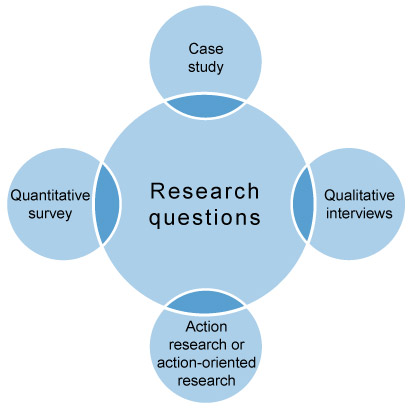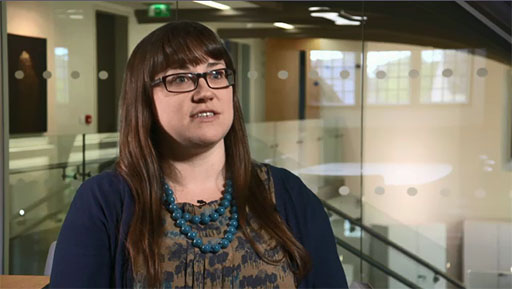6 Research strategy
A research strategy introduces the main components of a research project such as the research topic area and focus, the research perspective (see Sections 1 and 2), the research design, and the research methods (these are discussed below). It refers to how you propose to answer the research questions set and how you will implement the methodology.
In the first part of this course, you started to identify your research topic, to develop your research statement and you thought about possible research question(s). While you might already have clear research questions or objectives, it is possible that, at this stage, you are uncertain about the most appropriate strategy to implement in order to address those questions. This section looks briefly at a few research strategies you are likely to adopt.
Figure 5 shows the four main types of research strategy: case study, qualitative interviews, quantitative survey and action-oriented research. It is likely that you will use one of the first three; you are less likely to use action-oriented research.

Here is what each of these strategies entails:
- Case Study: This focuses on an in-depth investigation of a single case (e.g. one organisation) or a small number of cases. In case study research generally, information is sought from different sources and through the use of different types of data such as observations, survey, interviews and analysis of documents. Data can be qualitative, quantitative or a mix of both. Case study research allows a composite and multifaceted investigation of the issue or problem.
- Qualitative interviews: There are different types of qualitative interviews (e.g. structured, semi-structured, unstructured) and this is the most widely used method for gathering data. Interviews allow access to rich information. They require extensive planning concerning the development of the structure, decisions about who to interview and how, whether to conduct individual or group interviews, and how to record and analyse them. Interviewees need a wide range of skills, including good social skills, listening skills and communication skills. Interviews are also time-consuming to conduct and they are prone to problems and biases that need to be minimised during the design stage.
- Quantitative survey: This is a widely used method in business research and allows access to significantly high numbers of participants. The availability of online sites enables the wide and cheap distribution of surveys and the organisation of the responses. Although the development of questions may appear easy, to develop a meaningful questionnaire that allows the answering of research questions is difficult. Questionnaires need to appeal to respondents, cannot be too long, too intrusive or too difficult to understand. They also need to measure accurately the issue under investigation. For these reasons it is also advisable, when possible, to use questionnaires that are available on the market and have already been thoroughly validated. This is highly recommended for projects such as the one you need to carry out for this course. When using questionnaires decisions have to be made about the size of the sample and whether and when this is representative of the whole population studied. Surveys can be administered to the whole population (census), for example to all employees of a specific organisation.
- Action-oriented research: This refers to practical business research which is directed towards a change or the production of recommendations for change. Action-oriented research is a participatory process which brings together theory and practice, action and reflection. The project is often carried out by insiders. This is because it is grounded in the need to actively involve participants in order for them to develop ownership of the project. After the project, participants will have to implement the change.
Action-oriented research is not exactly action research, even though they are both grounded in the same assumptions (e.g. to produce change). Action research is a highly complex approach to research, reflection and change which is not always achievable in practice (Cameron and Price, 2009). Furthermore action researchers have to be highly skilled and it is unlikely that for this specific project you will be involved in action research. For these reasons this overview focuses on the less pure action-oriented research strategy. If you are interested in exploring this strategy and action research further, you might want to read Chapter 14 of Cameron and Price (2009).
It is possible for you to choose a strategy that includes the use of secondary data. Secondary data is data that has been collected by other people (e.g. employee surveys, market research data, census). Using secondary data for your research project needs to be justified in that it meets the requirements of the research questions. The use of secondary data has obvious benefits in terms of saving money and time. However, it is important to ascertain the quality of the data and how it was collected; for example, data collected by government agencies would be good quality but it may not necessary meet the needs of your project.
It is important to note that there should be consistency between the perspective (subjective or objective) and the methodology employed. This means that the type of strategy adopted needs to be coherent and that its various elements need to fit in with each other, whether the research is grounded on primary or secondary data.
Activity 7
Now watch this video clip in which Dr Rebecca Hewett, Prof Mark Saunders, Prof Gillian Symon and Prof David Guest discuss the importance of setting the right research question, what strategy they adopted to come up with specific research questions for their projects, and how they refined these initial research questions to focus their research.

Transcript
Make notes on how you might apply some of these strategies to develop your own research question.
There is no feedback on this activity.
